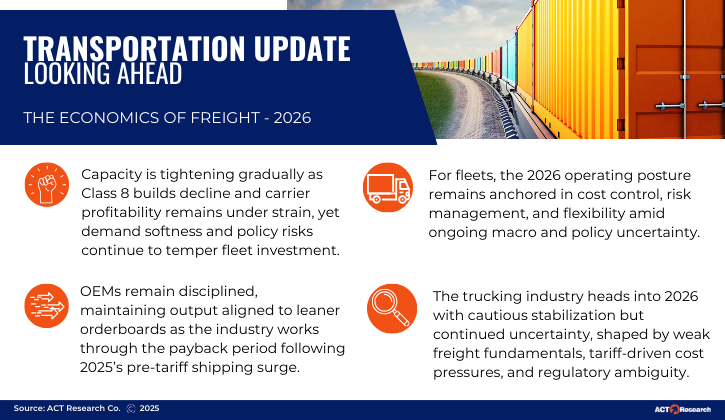
Trucking Industry 2026 Outlook
November 2025
Updated November 21, 2025
The trucking industry heads into 2026 with cautious stabilization but continued uncertainty, shaped by weak freight fundamentals, tariff-driven cost pressures, and regulatory ambiguity. Capacity is tightening gradually as Class 8 builds decline and carrier profitability remains under strain, yet demand softness and policy risks continue to temper fleet investment. OEMs remain disciplined, maintaining output aligned to leaner orderboards as the industry works through the payback period following 2025’s pre-tariff shipping surge.
Class 8 production slowed further through October as OEMs lowered build rates in response to weaker orders and elevated inventories, particularly in vocational categories. Order activity remained muted at the start of peak season, reflecting recession-like carrier margins and hesitancy around 2026 equipment costs. Fleets continue to focus on essential replacement amid higher prices tied to the 232 heavy-vehicle tariffs and uncertainty surrounding EPA 2027.
Medium-duty markets remained soft in October. While month-to-month orders improved, overall demand remains weak due to slower services activity, cautious consumers, and ongoing body-builder bottlenecks. Inventories, though off their midyear peak, remain above desired levels, prompting continued production restraint into early 2026.
Trailer demand stabilized at low volumes, showing slight improvement from earlier in the year but still well short of historical norms. Backlogs remain near rock-bottom levels even after a modest order uptick in October. OEMs report “below average but not dire” conditions as they manage build plans conservatively through 2026. Dry vans and reefers remain soft, while flatbeds show relative stability tied to select infrastructure needs.
Despite muted freight volumes, early signs of balance are emerging. Capacity is contracting slowly, used truck prices are stabilizing after several months of decline, and inventories are normalizing in the tractor market. Still, freight softness is expected to persist through early 2026, with the holiday season projected to produce negative real volume growth.
For fleets, the 2026 operating posture remains anchored in cost control, risk management, and flexibility amid ongoing macro and policy uncertainty.
3 Key Trends Impacting Trucking & Transportation in 2026
1. Fleet Renewal and Equipment Strategy
Fleets enter 2026 with aging tractors and delayed trade cycles following a year of weak Class 8 ordering. Purchases remain almost entirely replacement-focused, with little appetite for expansion given low profitability and higher acquisition costs. The §232 tariffs continue to increase new equipment prices materially, and insurance and financing costs remain elevated.
Dealer and OEM inventories are rebalancing but remain uneven—tractor inventories are nearing equilibrium while vocational levels remain high. Used truck prices have continued to soften but are showing early stabilization as production cuts take effect. Investment strategies are centered on ROI, uptime, and reliability rather than fleet growth.
2. Regulatory Shifts and Zero-Emission Readiness
EPA 2027 remains the most significant regulatory uncertainty. With no updated guidance issued and the implementation date approaching, industry expectations are shifting toward a partial rollback, particularly around warranty and useful-life extensions. The lack of clarity has eliminated prebuy incentives and slowed long-term capital planning.
Zero-emission truck adoption continues in targeted applications—urban delivery, drayage, and regional operations where infrastructure and incentives are available. Broader adoption remains limited by high upfront costs, infrastructure gaps, and uncertain policy timing. Fleets are maintaining pilot programs but delaying major commitments until both federal and state regulatory pathways become clearer.
3. Capacity Rebalancing and Freight Alignment
Freight markets are showing early but tentative signs of rebalancing. Class 8 builds have been cut meaningfully from early 2025 levels, and fleet capacity is beginning to contract as profitability remains near recessionary lows. Smaller carriers continue to face severe margin pressure and some consolidation is occurring, though supply still exceeds demand.
Carriers are prioritizing network efficiency, equipment utilization, and liquidity protection over growth. Private fleets continue to capture share through superior routing control and higher pay, reinforcing competitive pressures on the for-hire sector. ACT expects the imbalance between supply and demand to improve gradually through 2026, with meaningful freight and rate recovery not likely until the second half of the year.

Stay Ahead with Smarter Freight Insights
Success in trucking and freight comes from knowing what’s next—not just what’s now. At ACT Research, we deliver forward-looking market intelligence that helps you anticipate shifts, prepare for cycles, and stay strategically positioned. As your trusted transportation intelligence partner, we give you the tools to act with confidence—so you can optimize operations, reduce risk, and drive stronger profitability.